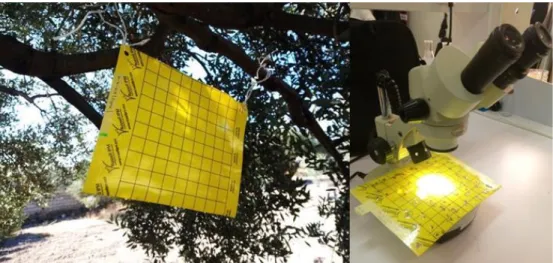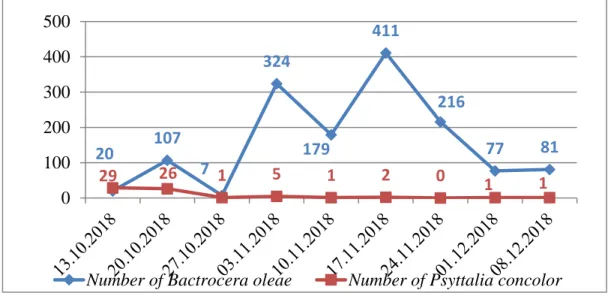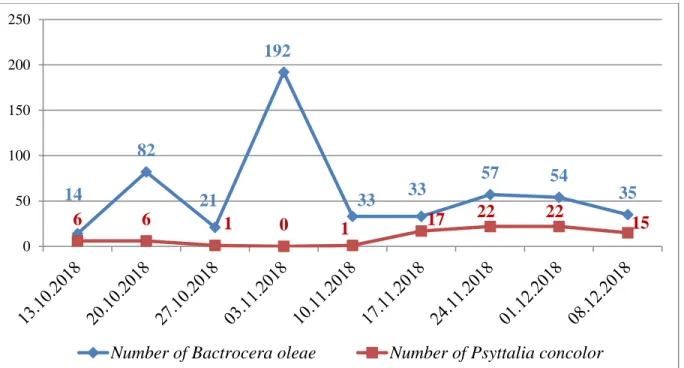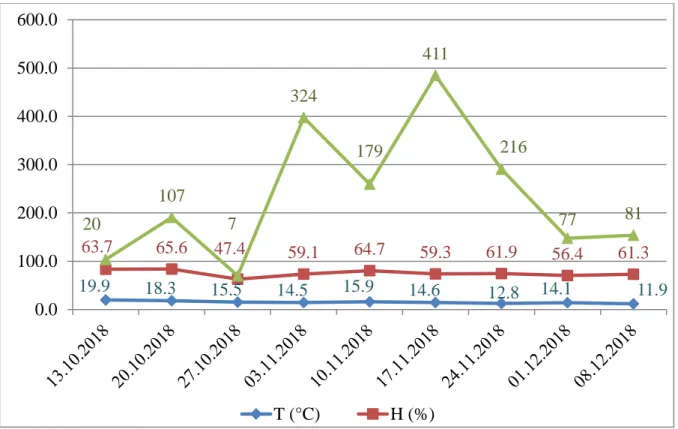Bioscience Research
Print ISSN: 1811-9506 Online ISSN: 2218-3973 Journal by Innovative Scientific Information & Services NetworkRESEARCH ARTICLE BIOSCIENCE RESEARCH, 2020 17(2): 994-1001. OPEN ACCESS
Population dynamics of Bactrocera oleae (Gmelin)
(Diptera: Tephritidae) on olive tree in Algeria
Nabila Boubekka
1and Yasmine Dahache
2Akli Mohand Oulhadj –Bouira (Algeria) University, Algeria
*Correspondence: n.boubekka@univ-bouira.dz Received 14-04-2020, Revised: 06-06-2020, Accepted: 08-06-2020 e-Published: 09-06-2020
This work concerns the study of the population dynamics of Bactrocera oleae (Gmelin) (Diptera: Tephritidae) as a function of some biotic and abiotic factors on two varieties of olive tree Sigoise and Azeradj, located in Kabylia (Algeria). Yellow sticky traps are chosen for weekly sampling from October 13 to December 08, 2018.The inventory noted 1943 individuals of Bactrocera oleae, of which 1 422 individuals (73.19%) are captured on the Sigoise variety, three generations follow one another on this variety. Males outnumber females with Sex-ratio values of 1.14 on the Azeradj variety and 2.13 on the Sigoise variety. Concerning the parasitoid Psyttalia concolor (Szépligeti) (Hymenoptera: Braconidae), 156 individuals are captured on the two varieties, 90 individuals (57.69%) on the Azeradj variety. The largest catches of adults of Bactrocera olea, 192 on the Azeradj variety and 411 on the Sigoise variety are recorded at around 14.5 ° C and 60% RH.
Keywords: Population dynamics, Bactrocera oleae, olive tree, Algeria
INTRODUCTION
The production of olive oil has a decisive role for economies and employment in Mediterranean regions. The interest which olive growing has undergone in the world in recent years has led Algeria to launch a development plan for the sector, focusing on quantity and quality. A national agricultural development plan has been implemented for the creation of a million hectares, to revive the Algerian olive cultivation (ITAF, 2012). In 2017, the total olive-growing area in Algeria was 432 916 hectares, including 60 969 641 trees, including 36 111 725 olive trees in production, with a yield of 19 kg / tree and 17.5 liters / quintal (APS, 2018a). The wilaya of Bouira has 37 000 ha of olive growing area, of which 27 000 are in production (APS, 2018b). As for the forecasts for the 2018/2019 campaign, according to IOC estimates, olive oil production in Algeria will drop by -7% or 76.500 tonnes compared to that of 2017/2018 (ONFAA, 2018). Phytosanitary
problems are among the factors that condition olive production, according to Abbassi et al., (2019), Aleurolobus olivinus causes direct damage to olive trees in Algeria, due to the toxins it injects into the plant and the transmission of viruses. The olive fly, Bactrocera oleae (Gmelin) (Diptera: Tephritidae) is considered one of the most formidable pests, attracting the attention of all olive growers, according to Athar (2005), this pest directly attacks the olive and can devastate whole crops. The attack of olives by the fly considerably reduces the content of phenolic compounds and therefore the stability of the oil to oxidation in a manner proportional to the importance of the attack.
In the perspective of contributing to the improvement of the production of olive oil and table olives and protecting the olive growing of this pest without resorting to the use of pesticides harmful to human health and the environment, we are trying by this study to have information on the
Boubekka and Dahache Population dynamics of Bactrocera oleae
Bioscience Research, 2020 volume 17(2):994-1001
995
influence of climatic factors on the population dynamics of this pest and to provide alternative solutions based on the role of natural enemies in the regulation of Bactrocera oleae populations in order to avoid economic damage, for this effect
Psyttalia concolor (Szépligeti) (Hymenoptera:
Braconidae) may be a good candidate. Laboratory tests have confirmed that all the larval instars of
B. oleae can be successfully parasitized by P. concolor (Raspi et al., 2019).
MATERIALS AND METHODS Study station
This present study took place in an olive grove of 1.2 ha located to the east of the town of Ath Mansour belonging to the wilaya of Bouira 150 km from Algiers (Algeria) (Fig, 1). According to the site https://fr.db-city.com/ , the town of Ath Mansour is a set of hills located at an Altitude of 323 m (36 ° 19 ′ 51 ″ North, 4 ° 18 ′ 4 ″ East ), characterized by a Mediterranean climate with a hot summer according to the Köppen Classification: Csa.
The study orchard is heterogeneous, made up of three varieties of olive tree Chemlal, Sigoise and Azeradj. This orchard is carried out in organic farming, two cultural practices a pruning and a plowing are carried out during the year of study but no phytosanitary treatment was used.
Biological material
Regarding the plant biological material, we opted for two local varieties that are Sigoise and Azeradj according ITAF (2012), these two
varieties are self-fertile for the production of olive oil and table olives with an oil yield of 20 to 28% for the Azeradj variety and 18% for the Sigoise variety. This last, appreciated for its quality of table olive. It is the source of most of the canned olives for local consumption and for exports (Hadjou et al., 2013).
Sampling method
Our study is carried out from October 13 to December 08, 2018, during this period 9 outings are carried out. Each week a sticky yellow plate of 20 / 24cm is placed on a branch of a tree chosen randomly for each of the two varieties (Sigoise and Azeradj) (Fig 2). The sticky yellow plates recovered after 07 days are brought to the laboratory for the determination and counting of the trapped individuals with a binocular magnifier. According to Franck (2013), sticky yellow plates are effective in quantifying a population of pests or auxiliaries.
Climate data
Climatic factors play a major role in the spatial distribution of animal and plant species (Dreux, 1980). Average temperatures and Humidity used in this study are recorded by Meteoblue (https://www.meteoblue.com/) for the year 2018. Since the sampling is carried out once a week, we have opted for the use weekly averages for average temperatures and relative humidity.
Bioscience Research, 2020 volume 17(2):994-1001
996
Figure 2: Sampling and determination of individuals of Bactrocera oleae and Psyttalia concolor
Statistical analysis
In order to study the importance of the link
between the variables (dose and mortality rate), the Pearson correlation coefficient was chosen because according to Rakotomalala (2015), the correlation coefficient is a measure of the intensity of the linear connection between two variables. The relationship (or the correlation) between the two variables is denoted by the letter r and quantified with number, wich varies between -1 and +1. Zero means there is no correlation, where 1 means a complete or perfect correlation. The sign of the r shows the direction of the correlation. A negative r means that the variables are inversely related. The strength of the correlation increases both from 0 to +1 and 0 to -1 ( Akoglu, 2018). This study is done on the Microsoft Office Excel 2010 software.
RESULTS AND DISCUSSION
Population dynamics of Bactrocera olea according to the variety of the olive tree
During this study a total of 1943 individuals of
Bactrocera olea are captured, it is on the sigoise
variety that we sampled the highest number with 1422 individuals, followed by the Azeradj variety with 521 individuals. Athar (2005), Rizzo and Caleca (2006) and Rizzo et al., (2012) note that the levels of infestation Bactrocera Olea
correlated to the size and hardness of the olives, the largest varieties of olives early maturing with large spherical and hard fruits are preferred by
Bactrocera Olea for laying than elongated, small
and soft fruits. If we compare the fruits of the Sigoise and Azeradj varieties, the fruit of the latter is larger, because according to (Tamendjari et al., 2009), the Azzeradj variety is characterized by its large fruits of 4-5 g, While the weight of the fruit of the sigoise variety according to Abdessemed et al., (2018) is 2.74 ± 0.46g only. The results recorded by this present study show that the Azeradj variety is the least visited by Bactrocera
oléa, despite the high size of its fruit, according to
Rizzo and Caleca (2006), the differences in sensitivity of the varieties can be usefully considered for obtain quality productions and reduce the use of insecticides in organic and conventional olive growing.
Comparison of the population dynamics of
Bactrocera oleae and Psyttalia concolor Concerning the parasitoid Psyttalia concolor, 156 individuals are sampled, 66 on the Sigoise variety and 90 on the Azeradj variety. Compared to the number of Bactrocera oleae trapped, the number of individuals of the parasite Psyttalia
concolor present in the Sigoise variety seems not
to be effective in limiting the proliferation of this pest, noting that from October 27 the number of the parasitoide Psyttalia concolor on this variety is very weak not exceeding 5 individuals, While the numbers of Bactrocera oleae reached peak of 324 individual on November 3 and 411 individual on November 17(fig. 3), this corroborates with the results of Hepdurgun et al., (2009), who noted that reducing the damage of Bactrocera olea by
Psyttalia concolor is not enough to reach the
Boubekka and Dahache Population dynamics of Bactrocera oleae
Bioscience Research, 2020 volume 17(2):994-1001
997
equal to -0.377 shows a weak negative correlation between the number of Bactrocera oléa and the number of the parasitoid Psyttalia concolor during the period from October 13 to November 10, however during the period from November 17 to 9 December we note a moderately positive correlation between these two species, results confirmed with a correlation coefficient equal to 0.507.
On Azeradj variety correlation coefficient equal to -0.515 shows a moderately negative correlation between the number of Bactrocera
Olea and number of parasitoid Psyttalia concolor
during the period from October 13 to 03 November, by cons during the period November 10 to December 9, there is a strongly positive correlation between the number of these two species, results demonstrated by a correlation coefficient equal to 0.714. The largest number of
Bactrocera olea was recorded on November 03
with 192 individuals, on that day a total absence of the parasitoid Psyttalia concolor was noted (fig. 4).
Bactrocera oleae sex ratio
On the two olive varieties, males are the most common than females but with different values, on the Sigoise variety 68% of the individuals of Bactrocera oleae captured are males, similarly on the Azeradj variety the males are always more abundant than the females with 53.17% (Fig. 5). Regarding the sex ratio, the highest value is recorded in the Sigoise variety with 2.13, this value shows that the number of females is greatly exceeded by that of males. On
the Azeradj variety the sex ratio is 1.14, the rations of the two sexes are close which means that the population is balanced in number of males and females. The large number of males captured compared to females can be explained either by a higher emergence rate in males compared to the female or by the fact that males are more attracted by the color yellow traps than females, because according to Genç and Nation (2008), Male and female emergence percentages ranged as 38.7–52.8, and 32–39.9%, respectively. While Byron and Nikos (2001) have found that the numbers of captured males is large on the plates of yellow and orange colors and while the plates of red and black colors attract females.
Population dynamics of Bactrocera olea according to climatic factors
On the Sigoise variety three generations of Bactrocera olea succeed one another, one generation is observed in October with a peak of 107 individuals and the other two generations are observed at the beginning and at the end of November with peaks respectively of 324 and 411 individuals, same observation in the Azeradj variety but with smaller numbers, according to Loussert and Brousse (1978), the phenology and abundance of Bactrocera oléa vary greatly depending on the geographical location of the olive tree and local conditions, varieties of olive tree, etc. The same authors add that the generations succeed each other until October-November at the rate of 25 days apart if the climatic conditions are favorable.
Figure 3: Population dynamics of B. oleae and P. concolor on the Sigoise variety
20
107
7
324
179
411
216
77
81
29
26
1
5
1
2
0
1
1
0
100
200
300
400
500
Bioscience Research, 2020 volume 17(2):994-1001
998
Figure 4: Population dynamics of B. oleae and P. concolor on the Azeradj varietyFigure 5: Rate of males and females of Bactrocera olea on the two varieties Sigoise and Azeradj
14
82
21
192
33
33
57
54
35
6
6
1
0
1
17
22
22
15
0 50 100 150 200 250Number of Bactrocera oleae
Number of Psyttalia concolor
0%
10%
20%
30%
40%
50%
60%
70%
Male
Female
Male
Female
Sigoise
Azeradj
68%
32%
53.17%
Boubekka and Dahache Population dynamics of Bactrocera oleae
Bioscience Research, 2020 volume 17(2):994-1001
999
Figure 6: Population dynamics of Bactrocera olea according to climatic factors on the Sigoisevariety
Figure 7: Population dynamics of Bactrocera olea according to climatic factors on the Azeradj variety
19.9
18.3
15.5
14.5
15.9
14.6
12.8
14.1
11.9
63.7
65.6
47.4
59.1
64.7
59.3
61.9
56.4
61.3
20
107
7
324
179
411
216
77
81
0.0
100.0
200.0
300.0
400.0
500.0
600.0
T (°C)
H (%)
19.9 18.3 15.5 14.5 15.9 14.6 12.8 14.1 11.9 63.7 65.6 47.4 59.1 64.7 59.3 61.9 56.4 61.3 14 82 21 192 33 33 57 54 35 0.0 50.0 100.0 150.0 200.0 250.0 300.0T (°C)
H (%)
Azeradj
Bioscience Research, 2020 volume 17(2):994-1001
1000
On the Azeradj variety, the values of the correlation coefficient equal to -0.144 show a very weak negative correlation between the number of
Bactrocera oléa and the weekly average
temperatures, same observation for the Sigoise variety with a correlation coefficient equal to -0.322. Concerning the effect of humidity, the values of the correlation coefficient equal to 0.193 and 0.085 obtained respectively on the Sigoise and Azeradj varieties show a very weak positive correlation between the number of Bactrocera
olea and the weekly average of relative humidity
recorded in the study station. During the study period the average weekly temperatures varied from 11.9 and 19.9 ° C, the weekly average relative humidity fluctuated between 47.4 and 65.6%, the largest catches of adults of Bactrocera
oléa, i.e. 192 on the Azeradj variety and 411 on
the Sigoise variety are recorded at around 14.5 ° C and 60% RH (Fig. 6 and 7), According to Genç and Nation (2008), An olive fruit fly colony was maintained on olives at 24 ± 1°C and 60% RH.
CONCLUSION
The comparison of the population dynamics of
Bactrocera oleae and its natural enemy Psyttalia concolor carried out on two varieties of olive tree
Sigoise and Azeradj revealed a strong presence of Bactrocera oleae. The variety Sigoise is the most appreciated by this pest with 1422 individuals, the number of individuals of the parasite Psyttalia concolor present at the level of this variety (66 individuals) seems not to be effective to limit the proliferation of this pest, noting that from October 27 the number of the parasitoide Psyttalia concolor is very low not exceeding 5 individuals. On the Azeradj variety, the largest number of Bactrocera olea was recorded on November 3 with 192 individuals, that day a total absence of the parasitoid Psyttalia
concolor was noted. Mass release from breeding
is more than necessary. In this orchard, males are more frequent than females with Sex-ratio values ranging from 1.14 on the Azeradj variety to 2.13 on the Sigoise variety. Concerning climatic factors, the most important traps of the adults of
Bactrocera oléa, that is 192 on the Azeradj variety
and 411 on the Sigoise variety are recorded around a weekly average of average temperature of 14.5 ° C and 60% RH.
CONFLICT OF INTEREST
The authors declared that present study was performed in absence of any conflict of interest.
ACKNOWLEGEMENT
We thank the Dahache family for allowing us to conduct this study in their olive groves, our thanks go to Professors Doumandji S. and Hacini S. for their help and encouragement
AUTHOR CONTRIBUTIONS
NB designed the theme, determined the species, analyzed the results, produced and examined the manuscript. YD carried out the insect sampling and participated in the analysis of the results. All authors have read and approved the final version.
Copyrights: © 2020@ author (s).
This is an open access article distributed under the terms of the Creative Commons Attribution License (CC BY 4.0), which permits unrestricted use, distribution, and reproduction in any medium, provided the original author(s) and source are credited and that the original publication in this journal is cited, in accordance with accepted academic practice. No use, distribution or reproduction is permitted which does not comply with these terms.
REFERENCES
Abbassi F., Benzehra A., Achouche A. 2019. Study of the bioecology of Aleurolobus
olivinus silvestri (1911) (homoptera, aleyrodidae) on olive trees in Algeria, Bioscience Research, 16(4):3489-3499. Abdessemed S., Abdessemed A., Boudchicha
R.H., Benbouza H., 2018. Caractérisation et identification de quelques écotypes d’olivier Olea europaea L en Algérie, Agriculture 8(2) : 26-43.
Akoglu H., 2018. User’s guide to correlation coefficients, Turkish Journal of Emergency Medicine 18. 91-93.
APS, 2018a. Oléiculture : une production 6.844.606 quintaux (qx) en 2017, Algérie Presse Service. Posted On: Sunday, July 15, 2018 19:30 [online] <http://www.aps.dz/algerie/76300> [visited: January 10, 2020].
APS 2018b. Cueillette des olives à Bouira : les champs reprennent des couleurs de saison, Algérie Presse Service. Posted On: Wednesday, December 12, 2018 14:16 [online]<http://www.aps.dz/algerie/76300>[vi sited: January 10, 2020].
Athar M., 2005. Infestation of Olive Fruit Fly, Bactrocera oleae, in California and
Boubekka and Dahache Population dynamics of Bactrocera oleae
Bioscience Research, 2020 volume 17(2):994-1001
1001
Taxonomy of its Host Trees. Agriculturae Conspectus Scientificus 70 ( 4 ): 135-138. Byron I. K., and Nikos A. K., (2001). Captures of
the olive fruit fly Bactrocera oleae on spheres of different colours. Entomologia Experimentalis et Applicata 100(1): 165-172. DB-City, 2020. https://fr.db-city.com/ [visited: April
2, 2020].
Dreux P., 1980. Précis d’écologie, Ed. Presses universitaires de France, Paris, 231p.
Frank A., 2013. Capture, conditionnement, expédition et mise en collection des insectes et acariens en vue de leur identification, Ed Cirad, Montpellier, 50 p.
Genç, H., Nation, J. L., 2008. Maintaining
Bactrocera oleae (Gmelin.) (Diptera: Tephritidae) colony on its natural host in the laboratory, Journal of Pest Science 81:167– 174.
Hadjou, L., Lamani, O., Cheriet F., 2013. Labellisation des huiles d’olive algériennes : contraintes et opportunités du processus ?. New Médit 12(2) :35-46.
Hepdurgun B., Turanli T., Zumreoglu A., 2009. Control of the olive fruit fly, Bactrocera oleae, (Diptera: Tephritidae) through mass trapping and mass releases of the parasitoid Psyttalia
concolor (Hymenoptera: Braconidae) reared
on irradiated Mediterranean fruit fly, Biocontrol science and technology 19 (1): 211-224.
ITAFV, 2012. La culture de l’olivier, Institut Technique de l’Arboriculture Fruitière et de la Vigne, Algiers, Algeria, 37p. Available from: http://www.itafv.dz/dg/manif/633.
Loussert R. et Brousse C., (1978). L’Olivier : techniques agricoles et production méditerranéenne. Paris : Maisonneuvre et larousse. P 437
Meteoblue, 2018.https://www.meteoblue.com/ [visited: April 2, 2019].
ONFAA, 2018. Note de conjoncture: le commerce international de l’huile d’olive, Observatoire National des Filières Agricoles et Agroalimentaires, Algiers, Algeria, 5p. Available from: http://onfaa.inraa.dz/
Rakotomalala R., 2015. Analyse de corrélation, Étude des dépendances, Variables quantitatives.
https://eric.univlyon2.fr/~ricco/cours/cours/An alyse_de_Correlation.pf
Raspi, A., Canale, A., Loni, A.,Bagnoli B., 2019. Osservazioni sul comportamento di
Psyttalia concolor nei confronti di Bactrocera oleae, Acta Italus Hortus 10:
198-201.
Rizzo, R., Caleca, V., 2006. Resistance to the attack of Bactrocera oleae (Gmelin) of some sicilian olive cultivars, Olivebioteq 2 : 291-298.
Rizzo, R., Lombardo, A.,Caleca, V., 2012. Relation of fruit color, elongation, hardness, and volume to the infestation of olive cultivars by the olive fruit fly, Bactrocera
oleae, Entomologia Experimentalis and Applicata 145(1):15-22.
Tamendjari, A., Sahnoune, M., Mettouchi, S., Angerosa, F., 2009. Effect of Bactrocera
oleae infestation on the olive oil quality of
three algerian varieties: Chemlal. Azzeradj and bouchouk, Rivista Italiana Delle Sostanze Grasse 86(2):103-111.



